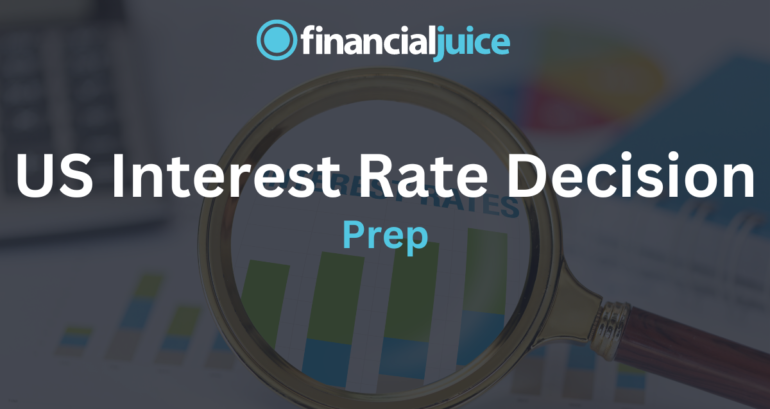
US Interest Rate Prep
On Wednesday the 1st of May at 14:00 ET, the Federal Reserve is set to announce the result of it’s latest monetary policy meeting.
The consensus is for the Interest Rate in the US to remain unchanged at 5.5%, so attention will turn to the Rate Statement, released with the Interest Rate decision, as well as the subsequent press conference from the Fed’s Chairman Powell. Markets will be looking for clues on the Federal Reserve’s thoughts on the future path of interest rates for the US.
Here are some views on what to expect.
Commentary
Unicredit
The Fed will very likely leave interest rates unchanged at the conclusion of its two-day meeting on 30 April-1 May.
We expect it to announce that it will slow the pace of quantitative tightening (QT), starting in June.
Chair Powell is likely to reiterate that the central bank is in no hurry to cut rates. We expect a total of 75bp of rate cuts this year, starting in September.
Recent macro data have not given the Fed the “greater confidence” it needs (that inflation is moving sustainably toward 2%) before it can cut rates.
Progress on disinflation has stalled. Following seven months of low inflation readings from June to December 2023, inflation has come in higher than expected for the past three months.
Core CPI inflation rose 0.4% mom in March for a third consecutive month.
Core PCE inflation (the Fed’s preferred measure of inflation) rose 3.7% annualized in 1Q24 after declining to 2.0% in 4Q23 and 3Q23.
Meanwhile, economic activity and employment have been resilient.
Real GDP expanded at a solid 1.6% annualized pace in 1Q24, driven by strong personal consumption growth of 2.5%.
Payrolls rose an average of 276k in 1Q24, an acceleration on the 212k average in 4Q23.
Societe Generale
At this FOMC meeting, the market will be looking for clues of further hawkishness from Powell at the post-meeting press conference and for changes to the statement that might acknowledge sticky inflation.
A slowdown in growth and a decisive shift in the disinflationary trend are throwing a wrench in the Fed’s easing bias.
Next week the Fed might announce a slower pace of Treasury run-offs starting in June, but with the recent decline in repo rates, it could hold off until the June meeting.
We expect Treasuries to stay within the range as we await more data.
Despite the continued bearish pressure on yields, our bias remains toward lower yields as ‘higher for longer’ and tightening financial conditions are likely to take a toll on the consumer.
Nomura
We expect communication on future easing to become more hawkish, potentially raising the threshold for an initial rate cut, in line with Fedspeak before the blackout period. The meeting statement is likely to show a less optimistic inflation assessment and less confidence in the medium-term outlook. In particular, we expect the opening paragraph of the statement to drop the line that “inflation has eased over the past year,” reverting to the simpler “inflation remains elevated.” This would reverse a change made at the December 2023 meeting.
We also expect the press conference to delve into the possibility that rates remain on hold this year, as well as how officials are considering the prospect of resumed rate hikes. Powell is likely to reiterate that cuts are the base case for this year. However, based on his rhetoric ahead of the blackout period, we expect he will hesitate to rule out more-hawkish outcomes. Powell will likely be asked about potential rate hikes, and there is a risk that an open-minded response generates hawkish headlines.
Morgan Stanley
We expect the FOMC to keep the fed funds rate unchanged at 5.375% (midpoint). Little change to the FOMC statement is expected, but we see the risk of a more hawkish press conference given Chair Powell’s recent commentary on the lack of progress on inflation. The emphasis should be on remaining patient as the FOMC awaits more convincing inflation data.
Wells Fargo
Stubborn inflation and resilient economic activity through the first few months of the year have left the FOMC little reason to ease policy in the near term. In addition, a chorus of Fed officials, which tellingly include a number of “doves,” have indicated that there is no hurry to cut rates at this time.
Continued patience from the Fed may be appropriate as consumers have demonstrated in this cycle that they will continue to spend even in the face of higher interest rates and inflation. Nominal personal spending improved by a better-than-expected 0.8% in March. On an inflation-adjusted basis, real spending has risen 0.5% in back-to-back months. Real disposable personal income rose 0.2% over the month, continuing to help firm up consumer spending. Households also remain comfortable dipping into savings to drive spending as the personal saving rate slid to 3.2% in March, the lowest since October 2022. A strong consumer isn’t necessarily a bad thing for the Fed, unless spending continues to feed into stronger-than-desired inflation pressures. Price growth was firm in Q1, placing more emphasis on Q2 to determine the eventual start of Fed easing.
Previous Release
On March the 20th at 14:00 ET the Federal Reserve announced the results of the last policy meeting.
It came in in-line with expectations, keeping the rate unchanged at 5.5%.
In the summary of economic projections released with the interest rate, the median FOMC projection implied 75bps of rate cuts this year.
After this we saw weakness in the dollar and government bond yields, and strength in US Stocks.




